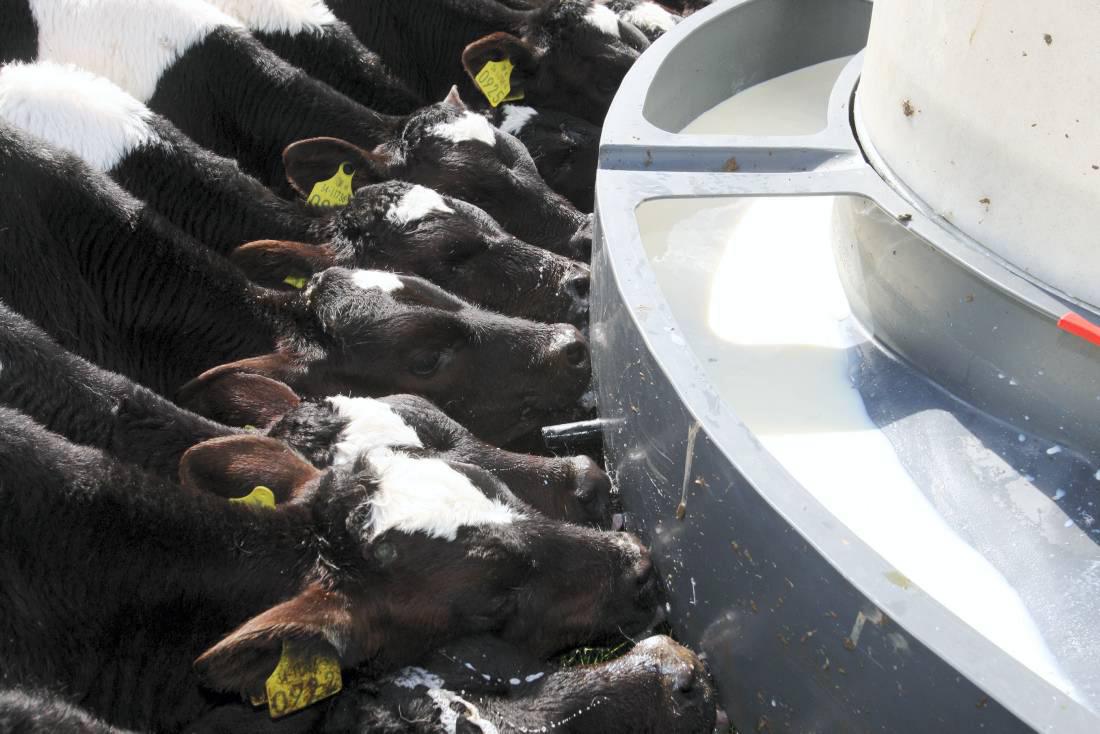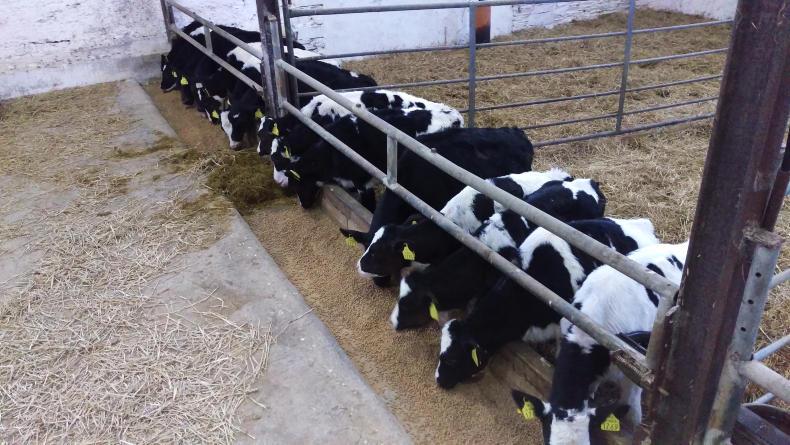Dairy calf rearers have traditionally restricted the amount of milk during the first few weeks of life in an effort to encourage solid feed intake and allow early weaning. Little consideration has been given to the possibility that early feeding practices could have a lasting influence on the subsequent productivity and longevity of these animals as lactating cows.
In recent times, there has been renewed interest and elevated awareness of the importance of early calf nutrition. Increasing numbers of studies report the benefits of improved nutritional status in the first two to three weeks may include reaching breeding age (and thus calving age) sooner, an improved ability to withstand infectious challenges, and increased subsequent milk production.
Conventional versus enhanced
In conventional feeding, it could be argued that we are feeding calves minimum nutrition rather than optimum nutrition. In the first few weeks of life, conventional feeding rates only provide enough nutrients for maintenance requirements and up to about 150-300g/day growth in normal environmental temperature ranges. Until calves concentrate intake increases sufficiently (typically doubling every week), there will not be enough nutrients consumed to allow calves to begin to grow rapidly and reach their genetic potential.
A contrasting feeding strategy is enhanced feeding, which allows calves’ much greater intakes of milk in early life, closer to natural or suckling conditions. Feeding rates are approximately twice those offered in conventional systems.
Milk replacers designed for use in these programmes are fed at a concentration of 1.5-1.75% and usually contain 24-26% CP. Compared to conventional rearing systems, the major difference in performance is seen in the first two to four weeks of life, and after that, growth rates between enhanced and conventional rearing programmes are generally similar.
To work successfully, enhanced feeding programmes need to be implemented with step-down or gradual weaning. To avoid or minimise growth slumps around weaning, calves should not be weaned until they are consistently eating 1-1.5kg of meal daily. While initial intake of concentrate will lag behind calves fed on conventional systems, they will increase at approximately the same rate once the amount of milk is cut back.
LifeStart Programme
In late 2014, the Nutreco LifeStart Programme was presented to farm advisers and scientists at a calf nutrition and health conference in Ireland. The LifeStart Programme is an enhanced feeding regime for calves and aims to deliver a significant effect on the performance and productivity of calves through a practical feeding plan utilising high-quality milk-based feed.
The key scientific principle behind LifeStart is metabolic programming. This is described as an improvement of the whole life health and performance of individuals beyond their full potential. In other words, the future of a cow is dictated by what and how much she eats as a calf. Nutreco reports that there is a critical window of opportunity at the start of the calf’s life (first two months) where nutrition can alter later cow performance and productivity.
For an enhanced feeding regime, the recommendation is to feed calves six litres/day (15% concentration; equating to 900g powder/calf/day), split between two or three feeds. Offer milk at this rate for 40-42 days and then start to reduce levels gradually to wean at 60-70 days. Target weight at 12 weeks is 115-120kg with an input of 48kg of milk powder.
Extra growth in the first three months has been reported in some studies to provide better mammary development, which is essential to the future productivity of the cow. Besides that, optimised calf growth can potentially reduce age at first calving and improvements in health and robustness.
Ongoing modelling research will look at the overall economic impact of accelerated milk feeding programmes in Irish-based dairy systems.
Nevertheless, at farm level there is a heightened awareness of the importance of the calf-rearing stage to the production cycle. To develop into a productive and profitable dairy cow, the newborn calf requires long-term financial investment.
Read more
Read the full Calf Focus supplement
Dairy calf rearers have traditionally restricted the amount of milk during the first few weeks of life in an effort to encourage solid feed intake and allow early weaning. Little consideration has been given to the possibility that early feeding practices could have a lasting influence on the subsequent productivity and longevity of these animals as lactating cows.
In recent times, there has been renewed interest and elevated awareness of the importance of early calf nutrition. Increasing numbers of studies report the benefits of improved nutritional status in the first two to three weeks may include reaching breeding age (and thus calving age) sooner, an improved ability to withstand infectious challenges, and increased subsequent milk production.
Conventional versus enhanced
In conventional feeding, it could be argued that we are feeding calves minimum nutrition rather than optimum nutrition. In the first few weeks of life, conventional feeding rates only provide enough nutrients for maintenance requirements and up to about 150-300g/day growth in normal environmental temperature ranges. Until calves concentrate intake increases sufficiently (typically doubling every week), there will not be enough nutrients consumed to allow calves to begin to grow rapidly and reach their genetic potential.
A contrasting feeding strategy is enhanced feeding, which allows calves’ much greater intakes of milk in early life, closer to natural or suckling conditions. Feeding rates are approximately twice those offered in conventional systems.
Milk replacers designed for use in these programmes are fed at a concentration of 1.5-1.75% and usually contain 24-26% CP. Compared to conventional rearing systems, the major difference in performance is seen in the first two to four weeks of life, and after that, growth rates between enhanced and conventional rearing programmes are generally similar.
To work successfully, enhanced feeding programmes need to be implemented with step-down or gradual weaning. To avoid or minimise growth slumps around weaning, calves should not be weaned until they are consistently eating 1-1.5kg of meal daily. While initial intake of concentrate will lag behind calves fed on conventional systems, they will increase at approximately the same rate once the amount of milk is cut back.
LifeStart Programme
In late 2014, the Nutreco LifeStart Programme was presented to farm advisers and scientists at a calf nutrition and health conference in Ireland. The LifeStart Programme is an enhanced feeding regime for calves and aims to deliver a significant effect on the performance and productivity of calves through a practical feeding plan utilising high-quality milk-based feed.
The key scientific principle behind LifeStart is metabolic programming. This is described as an improvement of the whole life health and performance of individuals beyond their full potential. In other words, the future of a cow is dictated by what and how much she eats as a calf. Nutreco reports that there is a critical window of opportunity at the start of the calf’s life (first two months) where nutrition can alter later cow performance and productivity.
For an enhanced feeding regime, the recommendation is to feed calves six litres/day (15% concentration; equating to 900g powder/calf/day), split between two or three feeds. Offer milk at this rate for 40-42 days and then start to reduce levels gradually to wean at 60-70 days. Target weight at 12 weeks is 115-120kg with an input of 48kg of milk powder.
Extra growth in the first three months has been reported in some studies to provide better mammary development, which is essential to the future productivity of the cow. Besides that, optimised calf growth can potentially reduce age at first calving and improvements in health and robustness.
Ongoing modelling research will look at the overall economic impact of accelerated milk feeding programmes in Irish-based dairy systems.
Nevertheless, at farm level there is a heightened awareness of the importance of the calf-rearing stage to the production cycle. To develop into a productive and profitable dairy cow, the newborn calf requires long-term financial investment.
Read more
Read the full Calf Focus supplement









SHARING OPTIONS